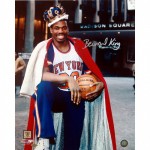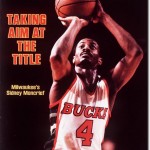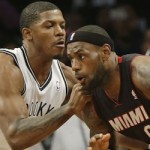
It doesn’t matter how hard he wishes for it. Sidney Moncrief will never join the same pantheon of scorers to which his contemporary Bernard King belongs.
He’ll never master the lightning-quick turnaround jumper, never score nearly 33 points a game and never take Broadway by storm because of it. Moncrief won’t tear his knee’s anterior cruciate ligament, then improbably recover and again awe an entire nation by pouring in 28 points a game with a revamped repertoire of shots.
Moncrief didn’t do any of this before retiring in 1991 from an NBA career spent mostly in Milwaukee. Don’t expect the 55-year-old to defy the laws of nature and limits of his own talent by starting now.
Still, there’s another exclusive club to which King belongs that Moncrief should soon enter. It’s the Naismith Memorial Basketball Hall of Fame, which on Monday announced King and six other players and coaches will be inducted this September.
That King has been inducted, and not Moncrief, is flat wrong.
Sure, Moncrief couldn’t put the ball in the basket with the ease of King. But he did nearly everything else better. Moncrief was just as talented and accomplished a defender as King was a scorer, and offense and defense are supposed to carry equal weight in determining a player’s value. King had his scoring crown; Moncrief had two defensive player of the year awards – the only perimeter defender in NBA history to accomplish this.
accomplished a defender as King was a scorer, and offense and defense are supposed to carry equal weight in determining a player’s value. King had his scoring crown; Moncrief had two defensive player of the year awards – the only perimeter defender in NBA history to accomplish this.
There are plenty of other reasons why Moncrief should join King in the Hall of Fame. Here are the top five:
1. He Won
Moncrief led the Milwaukee Bucks to seven consecutive division titles in the 1980s. They made three of four Eastern Conference finals in 1983-86. While the Bucks couldn’t break the stranglehold of eventual champions like Philadelphia and Boston, their fans still deeply appreciated Moncrief’s consistent effort. When he left Milwaukee after three injury-plagued seasons, the Milwaukee Journal Sentinel conducted a poll to determine its readers favorite all-time Buck. Moncrief finished first by a wide margin over Kareem Abdul-Jabbar and Oscar Robertson.
King’s five NBA teams never had anywhere near the same level of success as Moncrief’s Bucks.
2. His Mojo Went Beyond Defense
Early on, Moncrief showed he would be an exceptional player in all facets of the game. Despite standing 6-4 while starring for the University of Arkansas, he shot 62% from the field during his college career. He also remains the Hogs’ all-time leading rebounder.
Moncrief kept it up in the NBA and ranked among the game’s best all-around guards in the early to mid 1980s. He regularly put up more than 20 points a game while chipping four or five assists and six to seven rebounds.
“Sidney could do everything,” Larry Bird said in Moncrief’s autobiography Moncrief: My Journey To The NBA. “He was a lot stronger than he looked. He could post low; he had good sharp cuts in terms of jump shooting. He had perfect form – you’d want a kid to model jump shots after his.”
Indeed, Moncrief shot better than 80% from the free throw line and better than 50% from the field for his NBA entire career. There’s good reason the editors of Sports Illustrated’s The Basketball Book put him on their all-1980s second team along with Isiah Thomas, Charles Barkley, Dominique Wilkins and Moses Malone.
3. Eggheads Go Ga-Ga Over Him
The last time Sidney Moncrief was on the HOF ballot was the 2003, before advanced stats had permeated many fans’ understanding of the game. The explosion of analytics in the last decade should deepen our appreciation for players who not only stood above their own era’s peers, but stand up well against the best players of all eras.
 Moncrief stands up well by sporting a career Win Shares Per 48 minutes ranking of #30 all-time among NBA/ABA players. This means he contributed more to his team’s winning, on a per minute basis, than many other HOF inductees or certain future inductees (e.g. Kobe Bryant, Sam Jones, Kevin McHale and Hakeem Olajuwon.)
Moncrief stands up well by sporting a career Win Shares Per 48 minutes ranking of #30 all-time among NBA/ABA players. This means he contributed more to his team’s winning, on a per minute basis, than many other HOF inductees or certain future inductees (e.g. Kobe Bryant, Sam Jones, Kevin McHale and Hakeem Olajuwon.)
Indeed, Moncrief is the only non-HOF inductee or shoe-in in this stat’s all-time top 40. The #30 ranking was a big reason Moncrief made the cut last December in ESPN The Mag’s advanced stats-based Hall of Fame, ahead of Dwight Howard and Allen Iverson.
Moreover, ESPN basketball guru Bill Simmons ranks Moncrief as his No. 73 player of all time. Now that Bernard King is elected, Moncrief is the highest ranking player on this list not to be in the HOF. Here’s what Simmons wrote about him:
Moncrief was one of the defining what-if guys. If not for chronic knee problems that eventually derailed his career, Moncrief would have been the best all-around guard of the eighties and one of [Simmon’s top 45 players]. Before the days of arthroscopic surgery and ligaments that could be transferred from corpses, you were never the same after an ACL tear and that was that.
-excerpt from “The Book of Basketball” via arkansasexpats.com
4. He’s a Good Ambassador For the Game
Moncrief’s enduring popularity in Arkansas and Milwaukee stems from his ability to win ballgames, yes, but it also helps he has been a good guy. A lot of it is small things – not getting in trouble with the law, treating fans and the media with a smile, making sure his mother and wife shared in a two-minute standing ovation during his last home game as a Razorback. Proceeds made off of his autobiography benefited the Arkansas Food Bank and Hunger Task Force of Milwaukee.
The aggregate effect of this simple decency, combined with his competitiveness and workmanlike approach to the game, made him one of the game’s most respected leaders in the 1980s.
As Magic Johnson said in Moncrief’s autobiography, “What impresses me about Sidney is how hard he has always played, every minute. He is so talented, and I think of him as one of the quiet superstars – but superstar he is.”
Moncrief has helped teach the game and promote it around the world. He’s had assistant coaching jobs with Dallas, Golden State and, now, Milwaukee. He also served as consultant with the Beijing Ducks in 2009-10.
Bernard King, in contrast to Moncrief, battled quite a few demons early in life. During his college and early pro days, he was addicted to alcohol and was charged with sexual abuse of a woman. King did sober up and turn his life around, a storyline which adds to the legendary status he enjoys with some of the teams he played with post-treatment such as the New York Knicks.
5. He Had a Profound Influence on Society
Moncrief was born in September, 1957, the same month as the Little Rock Central High Crisis, which highlighted the racial tensions boiling underneath the surface of Arkansas society. More than any other Arkansas athlete, he helped alleviate those same tensions.
Since Arkansas has no major pro team, the Razorbacks essentially serve as both the state’s major pro and college team. As the most high profile star of the Hogs’ late 1970s teams, which won multiple SWC championships and made a Final Four, Moncrief became the first African-American “face” of an Arkansas sports team.
For the first time, white and black Arkansans embraced and looked up to a black student-athlete. The long-term social significance of such a watershed moment cannot be underestimated, especially considering it happened in a sports-crazed Southern state that had started integrating its high school only a decade before.
Moncrief’s influence would remain high in Arkansas throughout the 1980s as he became a superstar in the NBA and strengthened his friendships with prominent Arkansans such as then-governor Bill Clinton.
Moncrief no longer has the name recognition he once did, but that shouldn’t stop a campaign to get him put back on the ballot. Supporters should note it took Bernard King six years of nominations to finally secure the votes necessary to make the Hall of Fame. Moncrief has already been on the ballot five times. As with King, his sixth time around deserves to be a charm.
To get Moncrief back on the ballot, contact Matt Zeysing, the resident historian at the Basketball Hall of Fame in Springfield, Massachusetts. Nominations are taken throughout the year but the deadline for the Class of 2014 is Oct 31, 2013.
Demirel writes more about Moncrief – and his thoughts on compensation for student-athletes – here. He Tweets, too.












